Pike and musky flies are unique in the world of fly fishing. These flies are larger and flashier than many fly anglers are used to. Often, these flies require specialized fly fishing rigs to cast properly.
I have personally found the flies below to be very effective while fly fishing pike and musky. The pictures of flies that I have tied may be a bit rough around the edges. At the time of writing this, I only have flies that have caught a few fish, and are a bit chewed up. I need to tie up some more over the winter.
If you’re interested in learning more about fly fishing for pike and musky, see below:
Musky and Pike Fly Fishing Setup
Pike and Musky Fly Fishing Leaders
This post uses Amazon affiliate links. I receive a commission from any sales at no additional cost to yourself.
Niklaus Bauer’s Articulated Pike Popper
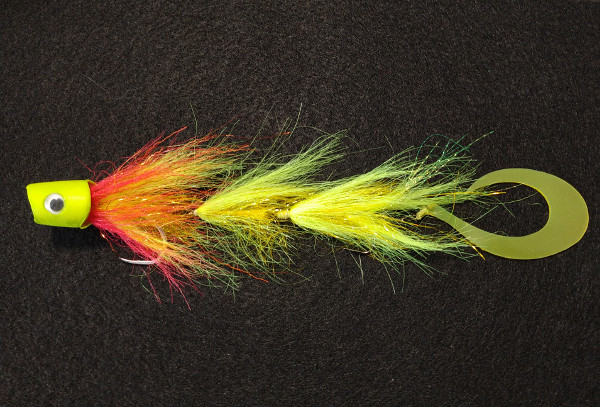
This pike popper was created with fishing big European pike in mind, but I have found significant success catching musky on this pattern here in Canada.
The design of this fly deals with the frequent short strikes common when fishing poppers. The back end of the fly acts as a stinger hook, catching some of the pike that short strike. The articulated back of the fly also hangs a bit lower in the water, which in my experience tends to reduce the number of refusals.
Tying instructions can be found here. Settle in. Like most large pike and musky patterns this fly takes a while to tie, especially the first few times.
The Howitzer Baitfish Popper Head makes a fantastic popping sound. You can use other popper heads when tying this fly, but much of the magic of this fly comes from the action given by the howitzer’s unique head design.
If at all possible, I recommend using Howitzers heads, although they can be a bit difficult to source in Canada. The below link has them on American’s Amazon. You’ll want to get the large size for these poppers.
Howitzer Baitfish Popper Heads Large White (Amazon Link)
The predator tail is another key component of the fly. You don’t have to use the exact tail mentioned in the video (as you can see above I didn’t, these are also quite hard to source in Canada). Any appropriately-sized predator tail will work. One thing the video doesn’t explain very well is how to attach this tail. I found tying it onto a small wire loop and then attaching that wire/tail combo to the fastach clip to work for me.
The fly isn’t particularly fun to cast, but it’s a ton of fun to fish. You’ll need at least a 10 weight to cast this popper fly effectively. Preferably outfitted with a pike or musky specific line designed to throw big flies.
I like using this fly when I know exactly where the fish are. The fly works well in the spring when the rivers are flooded. In the spring, the main river channel is raging with strong current from meltwater. The musky are isolated in the few pockets of calm water that can be found along the shore. This greatly reduces the amount of water you need to cover to find a fish.
I find hard, fast strips produce the best results with this fly. Watching the wake of a big musky chasing after this popper right before crushing it is quite the rush. Once you have a musky chasing the fly, don’t stop. Speed up the retrieve to mimic a prey item frantically trying to escape. If you pause or slow down once a musky is chasing, there’s a good chance the fish will lose interest.
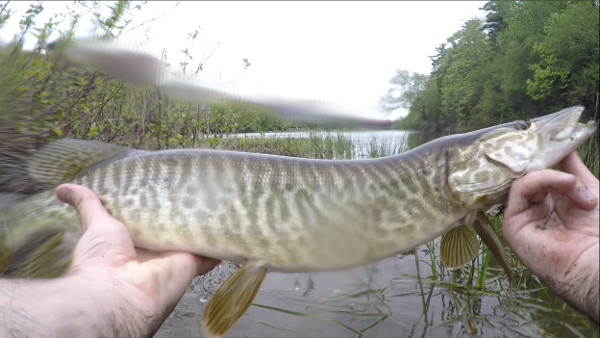
This is actually the fly that I caught my first musky on. The musky was caught on the opening day of the season. The fish was just a juvenile (pictured above) but bigger ones followed later in the season. You can see above that I’m in a little flooded back bay, removed from the raging main current of the river, which is visible in the distance.
Dahlberg Diver
I’ve really come to love dahlberg divers for targeting all predatory fish, not just pike and musky. They’re extremely versatile both in tying style and presentation options.
When retrieved quickly, this fly pattern mimics a baitfish zooming just below the surface by a few inches, which is an ideal strike zone for pike. Running depth can be adjusted by varying the buoyancy of the fly while tying it. Using more deer hair or foam will cause it to run shallower, while going sparser on the deer hair/foam will allow it to dive deeper on each strip.
When retrieved in short bursts, the fly mimics a frog swimming and resurfacing. This is a very productive retrieve along weedlines, and works for largemouth bass just as well as it works for pike and musky.
When retrieved slowly with long pauses, the dahlberg diver imitates a dying baitfish. I think it looks like a fish with a swimbladder issue having issues diving below the surface. This is an excellent presentation for opportunistic fish, and I’ve been able to trick some good sized musky with this presentation on very modest sized flies (4″-6″). If it’s a perceived easy meal, prey size doesn’t matter as much as if the musky has to invest effort into catching it.
Oversized Gurgler
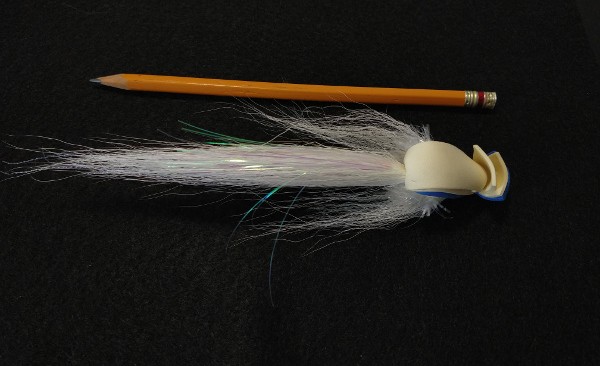
Gurglers are one of my favourite topwater flies to use for smallmouth bass. I thought why not size it up for Esox? Turns out, an oversized gurgler is very effective at targeting pike, and I’ve even caught a few musky on this fly as well. As an added bonus, large Smallmouth Bass will also strike at this fly (even with the wire leader), so it’s a good multi-species fly.
If I’m fishing topwater, this is my searching pattern. It’s much nicer to cast than popper flies, so you can cover more ground without wearing out your casting arm. Casting fatigue is a real issue when fishing these large flies, so it’s an important consideration.
The major difference between this gurgler and a standard gurgler (aside from size) is the addition of bucktail flaring out to either side. The extra bucktail gives the fly a wider profile. A standard gurgler pattern seemed to thin when tied this large. I also like to incorporate a fair bit of flash into the bottom of the tail.
The foam body is actually four layers of craft foam to give the appropriate amount of buoyancy for the hook size.
Buford Streamer
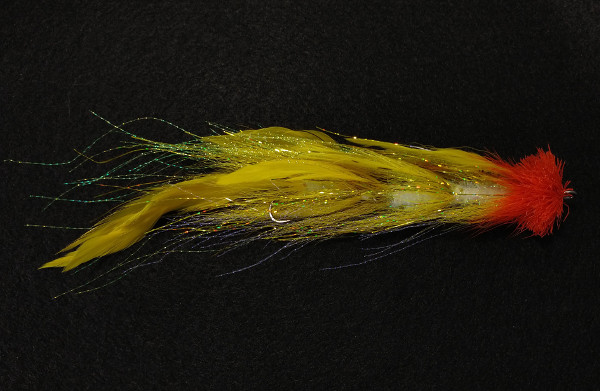
The Buford streamer is the gold standard when it comes to musky flies. It is the confidence fly of many musky anglers.
The design of this musky fly offers many opportunities for customization, but there are a few key components.
- Big deer hair head – Important for pushing water and triggering a muskies lateral line. If it’s your first time tying these flies, make the head a bit bigger than you think it needs to be. You can always trim the deer hair on the water if it ends up being too large.
- Articulated – The fly usually has atleast one articulation, and sometimes more. The large head makes the fly stop quickly after a strip, which can cause the tail of the fly to flick out to the side. A smaller hook in the back will help with this action. I sometimes tie the articulation using wire (similar to the pike popper listed earlier). Other times I use one or two Fish Skull Articulated Fish-Spine (Amazon Link)
for the front of the fly with a hook trailing off the end.
- Flash – Lots of flash. Musky and Pike are highly visual and respond well to flash. The side to side action of this fly will amplify any flash added. I’m a big fan of Flashabou, but as you can see in the picture above, I sometimes tie these with lots of Krystal flash as the primary flash.
You may be tempted to tie this pattern without the schapplen. I’ve tried this and really didn’t like the result. The resulting fly looks sparse and thin. A few pieces of schapplen strategically tied in really help to bulk the fly up without adding weight.
The bucktail must protect the feathers a bit, as they don’t (typically) immediately get cut off after the first fish. That is unless the fish really chomps down on the fly, but that will destroy any fly regardless of what it’s made out of.
These flies do require an aggressive sinking line to fish properly, as the large deer hair head wants to float. A sinking line will drag this fly down under the water. How deep the fly runs depends on the line used, and the speed of retrieve.
A nice advantage of this fly is that it will tend to float off the bottom, even with a sinking line pulling it down. This reduces likely hood of getting the fly snagged, unless you are fishing around logs raised off the bottom.
I’m primarily wading when I fish for Musky, so I’m fishing relatively shallow water. I’ve found the Scientific Anglers sinking line Hover/Sink 2/Sink 4 to work very well fishing the rivers around Ottawa. I have the fly line in size WF10 paired with a Redington Predator 10 weight (PIKE) fly rod.
Scientific Anglers Sonar Titan Hover/Sink 2 / Sink 4 Fly Line WF10S (Amazon Link)
Scientific Angler does have a faster sinking line available if you are fishing lakes or deeper rivers.
Pike Bunny
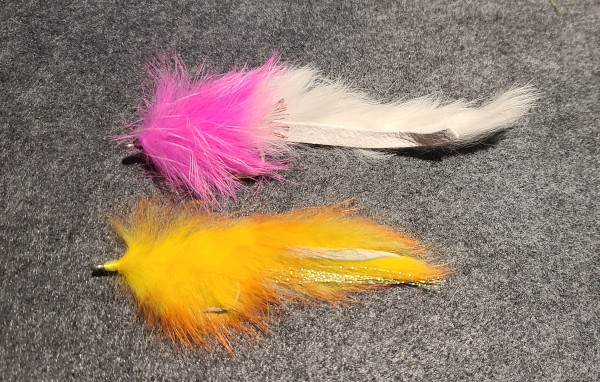
The humble pike bunny is honestly one of the most effective flies you can use. It’s simple to tie, uses cheap materials, and is relatively sturdy (until the tail comes off). You can crank out quite a few of these in a session of tie flying and be set for the fishing season.
These are my confidence pattern for pike fishing, and I always make sure to have atleast half a dozen on me. I tie them a few different ways. Sometimes they look like a tarpon fly, and other times they look more like an oversized slump buster pattern.
Rabbit strips provide excellent action in the water. With the right retrieve, you can get the fly undulating in much the same way a minnow wiggles as it swims.
The main drawback of pike bunny flies is that the tail can become fouled if tied to long. Tying support of some kind off the back of the hook under the bunny strip helps to reduce fouling. I usually use a wire loop for this. This drawback does mean that there’s an upper limit on how large these flies can realistically be tied.
One other drawback is that the fly is quite heavy when waterlogged, making it heavy for its size. This can make casting more difficult. Despite the negatives, this fly catches pike more consistently than any other fly I’ve tried.
In my opinion, the only material that gives better action than rabbit fur is marabou. Marabou is much too delicate for pike fishing though, and pike teeth will be shred marabou after only one fish. Leave marabou to the trout and bass flies.
Difference Between Pike and Musky Fly Selection
For some reason there are two very different schools of thought between what flies to use for pike vs what flies to use for musky. The difference is most obvious when you look at the most commonly recommended flies for each species. Taking two examples from earlier:
Pike: Pike Bunny
This is the most commonly recommended fly for pike. The pike bunny is simple, easy to tie, has limited flash, and is a fair bit smaller than the Buford, usually coming in at around 6″.
Musky: Buford Streamer
Often recommended for Musky. The Buford takes a long time to tie and has plenty of thought put into its design. This pattern often incorporates significant flash (not always) and can be over 12″ (and sometimes much larger). Most of the bufords I tie are between 8″ and 10″.
Why the Difference?
So why the difference in flies used for these two species? Honestly, I’m not sure. Truth be told I’ve caught muskies on pike bunnies and pikes on Bufords. It’s true that pike and musky are distinct species, but feeding habits are not different enough to warrant completely different fly recommendations when fishing the two species.
I think part of the reason is due to how the two species are perceived. Pike are often viewed as opportunistic predators that will strike at anything, while musky are often viewed as moody, selective, and elusive. I can tell you there are days when pike are very moody, and days when a musky will hit anything you throw in front of them.
Perhaps some of the misconceptions come from the fact that most water has a much lower population of musky than pike. I’m fortunate enough to live in the Ottawa area, which has a healthy (and relatively dense) musky population.
Fishing waters around Ottawa, I can tell you musky are not as elusive in this area as you might think from reading online forums. In fact, there are some stretches of water in which you will find much larger numbers of musky than pike. There are even areas right in the heart of Ottawa where you can reliably look over a bridge and see multiple muskies sunning themselves in a few feet of water.

I picture of the pike bunny would have been nice for us beginners.
You’re absolutely right.
I’ll take a a picture of one of my pike bunny flies and include it above.
Thank you for the feedback.
-Ben